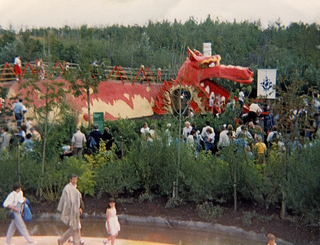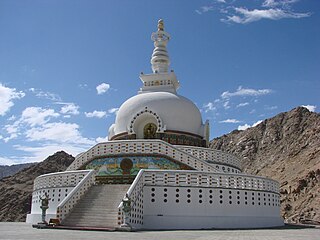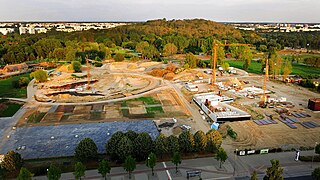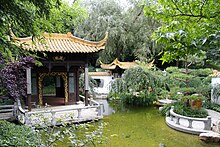
A world's fair, also known as a universal exhibition or an expo, is a large global exhibition designed to showcase the achievements of nations. These exhibitions vary in character and are held in different parts of the world at a specific site for a period of time, typically between three and six months.

The Englischer Garten is a large public park in the centre of Munich, Bavaria, stretching from the city centre to the northeastern city limits. It was created in 1789 by Sir Benjamin Thompson (1753–1814), later Count Rumford, for Prince Charles Theodore, Elector of Bavaria. Thompson's successors, Reinhard von Werneck (1757–1842) and Friedrich Ludwig von Sckell (1750–1823), advisers on the project from its beginning, both extended and improved the park.

The 1873 Vienna World's Fair was the large world exposition that was held from 1 May to 31 October 1873 in the Austria-Hungarian capital Vienna. Its motto was "Culture and Education".

The International Garden Festival was a garden festival recognised by the International Association of Horticultural producers (AIPH) and the Bureau International des Expositions (BIE), which was held in Liverpool, England from 2 May to 14 October 1984. It was the first such event held in Britain, and became the model for several others held during the 1980s and early 1990s. The aim was to revitalise tourism and the city of Liverpool which had suffered cutbacks, and the idea came from Conservative Environment Minister Michael Heseltine. The festival was hugely popular, attracting 3,380,000 visitors.

A Peace Pagoda is a Buddhist stupa: a monument to inspire peace, designed to provide a focus for people of all races and creeds, and to help unite them in their search for world peace. Most, though not all, peace pagodas built since World War II have been built under the guidance of Nichidatsu Fujii (1885–1985), a Buddhist monk from Japan and founder of the Nipponzan-Myōhōji Buddhist Order. Fujii was greatly inspired by his meeting with Mahatma Gandhi in 1931 and decided to devote his life to promoting non-violence. In 1947, he began constructing Peace Pagodas as shrines to world peace. The first was inaugurated at Kumamoto in 1954.
Ernst (Friedrich) Cramer was a Swiss landscape architect and one of the most renowned European garden architects after 1945, who had a strong influence on present-day landscape architecture in Europe.

Kienberg is a station on the U-Bahn in the German capital city of Berlin. It is located on the U5 line.

The Westpark is a large urban public park in Munich, Germany. It was designed by landscape architect Peter Kluska and completed in 1983. It hosted the International Garden Expo 83 that same year. The park covers an area of 720,000 m2 (7,750,016 sq ft) extending 2.6 km from east to west. The Garmischer Straße divides the park into an eastern and western section.

A garden festival is a festival and exposition held to celebrate the arts of gardening, garden design, landscaping and landscape architecture. There are local garden festivals, regional garden festivals, national garden festivals and international garden festivals. The idea probably originated with Germany's Bundesgartenschau. The UK held five garden festivals in the period 1984–1992.

The Munich tramway is the tramway network for the city of Munich in Germany. Today it is operated by the municipally owned Münchner Verkehrsgesellschaft and is known officially and colloquially as the Tram. Previous operators have included Société Anonyme des Tramways de Munich, the Münchner Trambahn-Aktiengesellschaft, the Städtische Straßenbahnen and the Straßenbahn München.

The G59 – 1st Swiss Horticulture Exhibition was the first of two Swiss horticulture exhibitions up until now. It took place from April 25 to October 11, 1959, in Zurich and covered an area of about 37 acres on the right and left banks of lower Lake Zurich. The two separate halves of the exposition were connected by commuter ferries and a specially created cable car.

The International Horticultural Exposition 1993 was held in Stuttgart, Germany. Recognised by the Bureau International des Expositions (BIE), the Expo ran from April 23, 1993, to October 17, 1993. Held at Wartenberg and Killesberg parks, the goal was to be visually and functionally integrated with two prominent features of Stuttgart's landscape, the Wartberg and the Leibfriedscher Garten. This was achieved. The long-term goal to create a U-shaped greenbelt around the city became a reality. The mascot of the horticultural show was "Flori", a bird in a cowboy hat. Overall, 7.3 million people visited the show, exceeding projections of 7 million.

The Internationale Gartenausstellung 2017 was an international horticultural exhibition that took place in Berlin, Germany, in 2017.

The 2003 World Horticultural Exposition was organized in the City of Rostock in Germany. It was the 17th international horticultural exposition which was recognized by the Bureau International des Expositions. The park was created in a derelict area around ruins of the former village of Schmarl, on the banks of the river Warnow. This made it possible to have a connection between water and gardens.
The International Gartenbauausstellung 73 was a garden festival held in Hamburg, Germany, which was recognized by the Bureau International des Expositions. The exposition was the 6th edition of the international horticultural exposition organised under the auspices of the Association of International Horticultural Producers (AIPH) and the second held at Planten un Blomen park in Hamburg. The exhibition took place on the same site where IGA 63 was held a decade earlier. There were some changes to the site location, such as the vaulting of the Marseillerstrasse so that visitors throughout the area without crossing could visit. Instead of a cable car, a park trail was constructed on the site to provide for visitors. The line had four stations and took 30 minutes to complete a lap.

Veli Turgay Ateş also known as Veli Türkay Ateş was a Turkish City and Urban planner and Landscape architect. He is graduated from M.E.T.U Fac. of Arch. Dept of City and Regional Planning in 1972, held his M.A degree in 1979 and held his Ph.D in Landscape Architecture, at Fac. of Agriculture, Dept. of Landscape Architecture in 1985. He has given lectures on urban design, Landscape architecture and to interior designers Advanced Design Graphics at M.E.T.U, University of Ankara, Bilkent University at related departments between 1976-1995 as a part-time instructor. He was the chief planner of Pioneer projects for Turkey during his duty as a consultant of the Mayor of Ankara between 1978-1980 like Batıkent Housing Project, Pedestrianization Project of Kızılay Central district, Bus-priority system for ANKARA. He has gold and silver medals for Turkish Garden’s which designed by him at the International Garden Festival at Liverpool and International Garden Expo 83 at Munich. At national competitions he won many prizes, among them Ulus city center reorganization Project, Adana 5 January City Square, İzmit, Gaziantep, Zonguldak Master Plans, İzmit and Eskişehir National Fairs, between 1972-1985. Since 1985 he has completed over 150 landscaping and urban design projects among them are many 5 star hotels, marinas, urban bridges, seafronts and private gardens.

The Königinstraße is a street in Munich. It runs west of the Englischer Garten from the Von-der-Tann-Straße in the district of Maxvorstadt, to the north and to the Maria-Josepha-Straße and Mandlstraße in the Ensemble Alt-Schwabing.
Roland Weber was a German landscape architect.
Johanne-Catharina Tecklenborg was a German painter.

The Chinese Tower is a 25-metre wooden building resembling a pagoda at the Englischer Garten in Munich, Germany. The building was constructed from 1789 to 1790 and was opened to the public as an observation deck during the opening of the Englischer Garten in 1792. The tower burned down during the bombing of Munich during World War II and was reopened as a reconstruction in 1952. Today the tower is considered a landmark of the Englischer Garten.
















